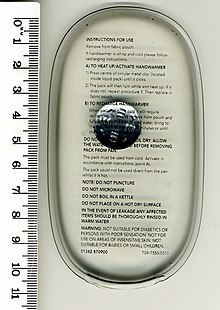Sodium acetate: Difference between revisions
L Kensington (talk | contribs) m Reverted edits by 99.28.99.239 (talk) to last revision by 128.175.54.208 (HG) |
Removed "Sodium Salt" from other names because that's sodium chloride (table salt) and not this stuff at all. ~~~~ |
||
| Line 14: | Line 14: | ||
| ImageNameR1 = The sodium cation |
| ImageNameR1 = The sodium cation |
||
| SystematicName = Sodium ethanoate |
| SystematicName = Sodium ethanoate |
||
| OtherNames = Sodium |
| OtherNames = Hot ice (Sodium acetate trihydrate) |
||
Hot ice (Sodium acetate trihydrate) |
|||
| Section1 = {{Chembox Identifiers |
| Section1 = {{Chembox Identifiers |
||
| CASNo_Ref = {{cascite}} |
| CASNo_Ref = {{cascite}} |
||
Revision as of 02:35, 22 August 2010

| |||
| |||
| Names | |||
|---|---|---|---|
| IUPAC name
Sodium acetate
| |||
| Systematic IUPAC name
Sodium ethanoate | |||
| Other names
Hot ice (Sodium acetate trihydrate)
| |||
| Identifiers | |||
| ChemSpider | |||
| ECHA InfoCard | 100.004.386 | ||
| E number | E262 (preservatives) | ||
PubChem CID
|
|||
| RTECS number |
| ||
CompTox Dashboard (EPA)
|
|||
| Properties | |||
| C2H3NaO2 | |||
| Molar mass | 82.0338 g/mol (anhydrous) 136.08 g/mol (trihydrate) | ||
| Appearance | White deliquescent powder odorless | ||
| Density | 1.528 g/cm3 1.45 g/cm3 (trihydrate) | ||
| Melting point | 324 °C (anhydrous) 58 °C (trihydrate) | ||
| Boiling point | 881.4 °C (anhydrous) 122 °C (trihydrate) | ||
| 36.2 g/100 ml (0°C) 46.4 g/100 mL (20°C) 139 g/100 mL (60°C) 170.15 g/100 mL (100°C) | |||
| Solubility | soluble in ethanol (5.3 g/100 mL (trihydrate) | ||
| Basicity (pKb) | 9.25 | ||
Refractive index (nD)
|
1.464 | ||
| Structure | |||
| monoclinic | |||
| Hazards | |||
| Occupational safety and health (OHS/OSH): | |||
Main hazards
|
Irritant | ||
| NFPA 704 (fire diamond) | |||
| Flash point | 250 °C | ||
| Related compounds | |||
Other anions
|
Sodium formate Sodium propionate | ||
Other cations
|
Potassium acetate Calcium acetate | ||
Except where otherwise noted, data are given for materials in their standard state (at 25 °C [77 °F], 100 kPa).
| |||
Sodium acetate (also sodium ethanoate) is the sodium salt of acetic acid. This colourless salt has a wide range of uses.
Applications
Industrial
Sodium acetate is used in the textile industry to neutralize sulfuric acid waste streams, and as a photoresist while using aniline dyes. It is also a pickling agent in chrome tanning, and it helps to retard vulcanization of chloroprene in synthetic rubber production.
Food
Sodium acetate may be added to foods as a seasoning. It may be used in the form of sodium diacetate — a 1:1 complex of sodium acetate and acetic acid,[1] given the E-number E262. A frequent use of this form is in salt and vinegar chips in the United States. Many US brands, including national manufacturer Frito Lay, sell "salt and vinegar flavored" chips that use this chemical, with lactose and smaller percentages of other chemicals, in lieu of a real salt and vinegar preparation.[2]
Buffer solution
As the conjugate base of a weak acid, a solution of sodium acetate and acetic acid can act as a buffer to keep a relatively constant pH. This is useful especially in biochemical applications where reactions are pH dependent.
Heating pad
Sodium acetate is also used in consumer heating pads or hand warmers and is also used in hot ice. Sodium acetate trihydrate crystals melt at 58 °C, dissolving in their water of crystallization. When they are heated to around 100 °C, and subsequently allowed to cool, the aqueous solution becomes supersaturated. This solution is capable of cooling to room temperature without forming crystals. By clicking on a metal disc in the heating pad, a nucleation center is formed which causes the solution to crystallize into solid sodium acetate trihydrate again. The bond-forming process of crystallization is exothermic, hence heat is emitted.[3][4][5] The latent heat of fusion is about 264–289 kJ/kg.[6] Unlike some other types of heat packs that depend on irreversible chemical reactions, sodium acetate heat packs can be easily recharged by boiling until all crystals are dissolved. Therefore they can be reused indefinitely.[7]

Preparation

For laboratory use, sodium acetate is inexpensive, and is usually purchased instead of being synthesized. It is sometimes produced in a laboratory experiment by the reaction of acetic acid with sodium carbonate, sodium bicarbonate, or sodium hydroxide. These reactions produce aqueous sodium acetate, and water. Carbon dioxide is produced in the reaction with sodium carbonate and bicarbonate, and it leaves the reaction vessel as a gas (unless the reaction vessel is pressurized). This is the well-known "volcano" reaction between baking soda and vinegar.
- CH3COOH + NaHCO3 → CH3COONa + H2O + CO2
Industrially, sodium acetate is prepared from glacial acetic acid and sodium hydroxide.
- C2H4O2 + NaOH → NaO2CCH3 + H2O
Reactions
Sodium acetate can be used to form an ester with an alkyl halide such as bromoethane:
- NaO2CCH3 + BrCH2CH3 → C2H5O2CCH3 + NaBr
Caesium salts catalyze this reaction.
References
- ^ http://www.jungbunzlauer.com/products-applications/products/specialties/sodium-diacetate/general-information.html
- ^ http://www.fritolay.com/our-snacks/lays-salt-vinegar.html
- ^ "Crystallization of Supersaturated Sodium Acetate". Journal of Chemical Education.
- ^ Fake latent heat and supersaturation
- ^ "How do sodium acetate heat pads work?". HowStuffWorks. Retrieved 2007-09-03.
- ^ Thermal Energy Storage: Systems and Applications, By Ibrahim Dincer, Marc A. Rosen, p. 155 [1]
- ^ "Infinite Activations". Cloud Depot Nine.



